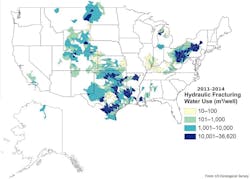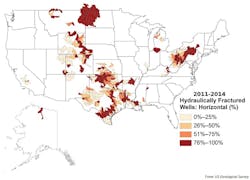USGS: Water usage for fracturing varies widely across shale plays
The volume of water required to hydraulically fracture wells varies widely across the country, according to the first national analysis and map of hydraulic fracturing water usage detailed in a recent US Geological Survey study.
The analysis was published in Water Resources Research, a journal of the American Geophysical Union. Researchers found water volumes for fracturing varied from 2,600 gal to 9.7 million gal per well.
As of 2014, median annual water volume estimates for fracturing in horizontal wells increased to more than 4 million gal/well for oil wells and 5.1 million gal/well for gas wells. That compared with an initial average of about 177,000 gal/well for oil and gas wells in 2000, the study said.
“One of the most important things we found was that the amount of water used per well varies quite a bit, even within a single oil and gas basin,” said USGS scientist Tanya Gallegos, the study’s lead author. “A better understanding of the volumes of water injected for hydraulic fracturing could be a key to understanding the potential for some environmental impacts.”
USGS noted that horizontal drilling accounted for the highest average water use for fracturing in 52 out of the 57 watersheds studied. The watersheds where the most water was used to fracture wells involved shale formations.
Horizontal wells generally require more water than vertical or directional wells. USGS said this research was part of its larger effort to understand the resource requirements and potential environmental impacts of unconventional oil and gas development.


